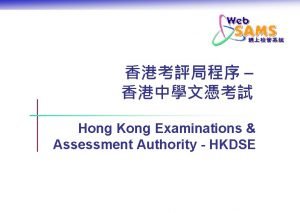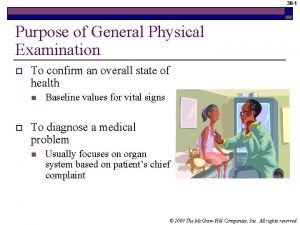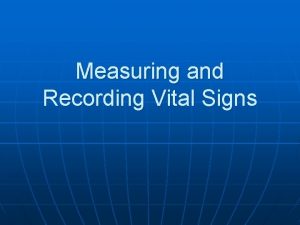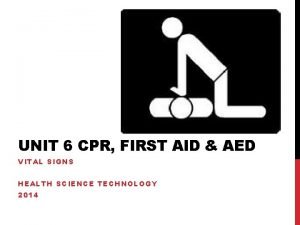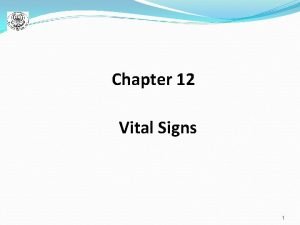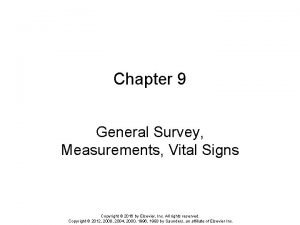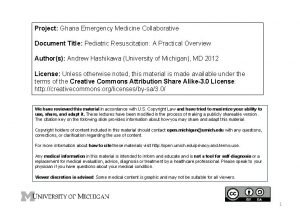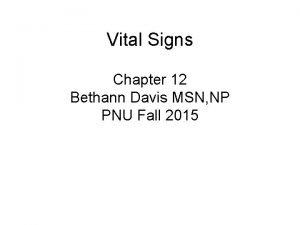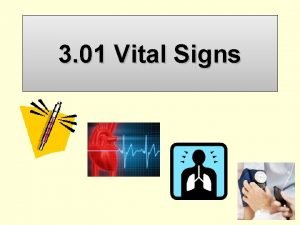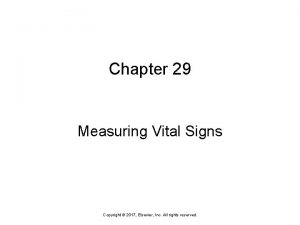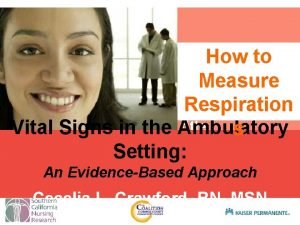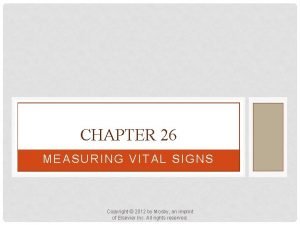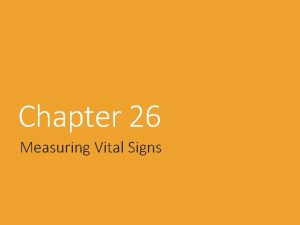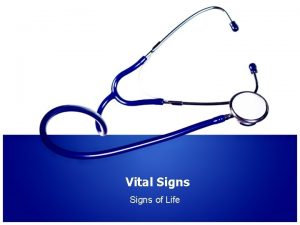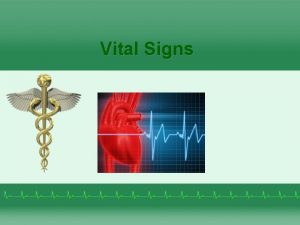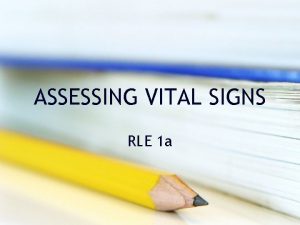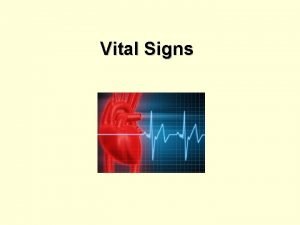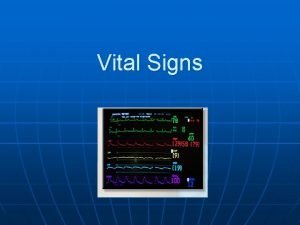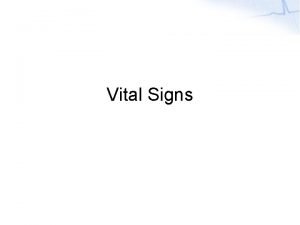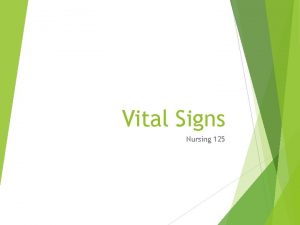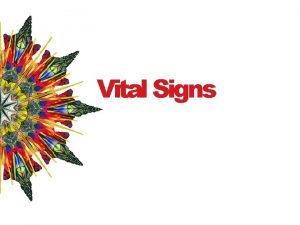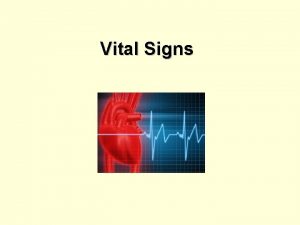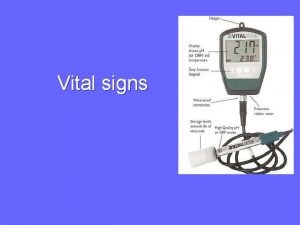Session 6 Examinations of Vital Signs 180 Minutes
































- Slides: 32

Session 6 – Examinations of Vital Signs 180 Minutes Session 6 Examinations of Vital Signs Preliminary Training for Drug Evaluation and Classification Program

Session 6 – Examinations of Vital Signs Learning Objectives • List the vital signs that are utilized in the DRE examinations • Define basic terms relevant to pulse rate and blood pressure measurements • Measure pulse rate • Measure blood pressure • Relate the expected results of vital signs examinations to the various categories of drugs Preliminary Training for Drug Evaluation and Classification Program 6 -2

Session 6 – Examinations of Vital Signs • Pulse rate • Blood pressure • Temperature Different types of drugs affect these vital signs in different ways Preliminary Training for Drug Evaluation and Classification Program 6 -3

Session 6 – Examinations of Vital Signs Definitions Concerning “Pulse” • Pulse The expansion and contraction of an artery generated by the pumping action of the heart • Pulse Rate The number of pulsations in an artery per minute • Artery A strong, elastic blood vessel that carries blood from the heart to the body tissues • Vein A blood vessel that carries blood back to the heart from the body tissues Preliminary Training for Drug Evaluation and Classification Program 6 -4

Session 6 – Examinations of Vital Signs Radial Artery Pulse Point Preliminary Training for Drug Evaluation and Classification Program 6 -5

Session 6 – Examinations of Vital Signs Brachial Artery Pulse Point Preliminary Training for Drug Evaluation and Classification Program 6 -6

Session 6 – Examinations of Vital Signs Carotid Artery Pulse Point Preliminary Training for Drug Evaluation and Classification Program 6 -7

Session 6 – Examinations of Vital Signs Basic Do’s and Don’ts of Measuring Pulse • Don’t use your thumb to apply pressure • If you use the carotid artery pulse point, don’t apply pressure to both sides of the middle of the throat • When measuring the pulse rate, use 30 seconds as the standard time interval • Pulse rate is always expressed as “beats per minute” • The pulse reading should not be an odd number Preliminary Training for Drug Evaluation and Classification Program 6 -8

Session 6 – Examinations of Vital Signs Pulse Hands On Practice • Work in pairs, taking turns measuring each other’s pulse • Record partner’s pulse rate Preliminary Training for Drug Evaluation and Classification Program 6 -9

Session 6 – Examinations of Vital Signs Definitions Concerning “Blood Pressure” • Blood Pressure The force that the circulating blood exerts on the walls of the arteries • Systolic Pressure The maximum blood pressure, reached as the heart contracts • Diastolic Pressure The minimum pressure, reached when the heart is fully expanded Preliminary Training for Drug Evaluation and Classification Program 6 -10

Session 6 – Examinations of Vital Signs Sphygmomanometer Preliminary Training for Drug Evaluation and Classification Program 6 -11

Session 6 – Examinations of Vital Signs Sphygmomanometer Demonstration Preliminary Training for Drug Evaluation and Classification Program 6 -12

Session 6 – Examinations of Vital Signs Sphygmomanometer Demonstration (Cont. ) Preliminary Training for Drug Evaluation and Classification Program 6 -13

Session 6 – Examinations of Vital Signs The Basics of Blood Pressure Measurement • Apply enough air pressure to cut off the flow of blood through the artery • Slowly release the air, about 2 mm. Hg per second, until the blood just begins to spurt through the artery: THAT WILL BE THE SYSTOLIC PRESSURE • Continue to release the air until the blood flows continuously: THAT WILL BE THE DIASTOLIC PRESSURE Preliminary Training for Drug Evaluation and Classification Program 6 -14

Session 6 – Examinations of Vital Signs Taking Blood Pressure with a Stethoscope Preliminary Training for Drug Evaluation and Classification Program 6 -15

Session 6 – Examinations of Vital Signs Korotkoff Sounds Click to Hear Audio Sample of Korotkoff Sounds Phase 1 begins Systolic Clear, tapping sounds Phase 2 begins Sounds change to murmur, take on a “swishing” quality Phase 3 begins Sounds develop a loud, knocking quality Phase 4 begins Sounds Become muffled, faint “swishing” quality Phase 5 begins Diastolic The sounds cease Preliminary Training for Drug Evaluation and Classification Program 6 -16

Session 6 – Examinations of Vital Signs Sphygmomanometer MANOMETER (Pressure Gauge) COMPRESSION CUFF PRESSURE CONTROL VALVE TUBES PRESSURE BULB Preliminary Training for Drug Evaluation and Classification Program 6 -17

Session 6 – Examinations of Vital Signs Details of Blood Pressure Measurement 1. Position cuff on bicep so that tubes extend down middle of arm 2. Wrap cuff snugly around bicep 3. Clip manometer to the subject’s sleeve or in a location to easily see the gauge 4. Twist pressure control valve all the way to the right Preliminary Training for Drug Evaluation and Classification Program 6 -18

Session 6 – Examinations of Vital Signs Details of Blood Pressure Measurement (Cont. ) 5. Put stethoscope earpieces in your ears 6. Apply the stethoscope to the brachial artery pulse point 7. Rapidly inflate bladder to a level high enough to squeeze the artery shut (Normally 180) Preliminary Training for Drug Evaluation and Classification Program 6 -19

Session 6 – Examinations of Vital Signs Details of Blood Pressure Measurement (Cont. ) 8. Twist the pressure control valve slightly to the left (pressure should drop at 2 mm. Hg per second) 9. Keep your eyes on the gauge and listen for the Korotkoff sounds Preliminary Training for Drug Evaluation and Classification Program 6 -20

Session 6 – Examinations of Vital Signs Blood Pressure Values • Systolic: 120 -140 • Diastolic: 70 -90 Some people can have significantly different blood pressures Preliminary Training for Drug Evaluation and Classification Program 6 -21

Session 6 – Examinations of Vital Signs Do’s and Don’ts of Blood Pressure Measurement Preliminary Training for Drug Evaluation and Classification Program 6 -22

Session 6 – Examinations of Vital Signs Participant’s Initial Practice at Measuring Blood Pressure Preliminary Training for Drug Evaluation and Classification Program 6 -23

Session 6 – Examinations of Vital Signs Measuring Body Temperature • Oral thermometer recommended • Always use protective disposable mouthpiece • Position thermometer under the subject’s tongue • Have subject refrain from talking when measuring temperature • Refrain from letting subject drink hot or cold fluids immediately prior to measuring temperature Preliminary Training for Drug Evaluation and Classification Program 6 -24

Session 6 – Examinations of Vital Signs Measuring Pulse Rate Preliminary Training for Drug Evaluation and Classification Program 6 -25

Session 6 – Examinations of Vital Signs Measuring Blood Pressure Preliminary Training for Drug Evaluation and Classification Program 6 -26

Session 6 – Examinations of Vital Signs DRE Ranges of Vital Signs • Pulse Rate: • 60 to 90 beats per minute • Blood Pressure: • Systolic – 120 to 140 mm. Hg • Diastolic – 70 to 90 mm. Hg • Body Temperature: • 98. 6 degrees Fahrenheit plus or minus one degree Preliminary Training for Drug Evaluation and Classification Program 6 -27

Session 6 – Examinations of Vital Signs Drug Categories and Vital Signs • All seven categories of drugs ordinarily will affect pulse rate and blood pressure • Some categories usually will lower pulse and blood pressure Preliminary Training for Drug Evaluation and Classification Program 6 -28

Session 6 – Examinations of Vital Signs Drug Categories and Vital Signs (Cont. ) Preliminary Training for Drug Evaluation and Classification Program 6 -29

Session 6 – Examinations of Vital Signs Drug Categories and Vital Signs (Cont. ) Which drugs affect muscle tone? Preliminary Training for Drug Evaluation and Classification Program 6 -30

Session 6 – Examinations of Vital Signs Drug Categories and Vital Signs (Cont. ) Practice Preliminary Training for Drug Evaluation and Classification Program 6 -31

Session 6 – Examinations of Vital Signs QUESTIONS? Preliminary Training for Drug Evaluation and Classification Program
 Sign shapes meaning
Sign shapes meaning 1 min to hour
1 min to hour Sample minutes of lac session
Sample minutes of lac session Capacidad vital y capacidad vital forzada
Capacidad vital y capacidad vital forzada Examinations.ie marking scheme
Examinations.ie marking scheme St. joseph of cupertino prayer
St. joseph of cupertino prayer Hk examination authority
Hk examination authority Aegrotat uoa
Aegrotat uoa New york state teacher certification exams
New york state teacher certification exams General physical examination
General physical examination Tyre impression forensic science
Tyre impression forensic science Frontal/coronal plane
Frontal/coronal plane Measuring and recording vital signs
Measuring and recording vital signs Positive orthostatic vitals
Positive orthostatic vitals Chapter 15:1 measuring and recording vital signs
Chapter 15:1 measuring and recording vital signs 6 vital signs first aid
6 vital signs first aid Vital signs height and weight
Vital signs height and weight Pulse grading 2+
Pulse grading 2+ Sign chapter 12
Sign chapter 12 Vital signs chart
Vital signs chart Orthostatic vital signs
Orthostatic vital signs Pulse locations
Pulse locations Normal vitals in pediatrics
Normal vitals in pediatrics Msn signs
Msn signs Abhishek oswal age
Abhishek oswal age Vital signs
Vital signs Where is apical pulse taken
Where is apical pulse taken Regular vital signs
Regular vital signs Chapter 29 measuring vital signs
Chapter 29 measuring vital signs Newborn respiratory rate
Newborn respiratory rate Chapter 26 measuring vital signs
Chapter 26 measuring vital signs Finding the brachial pulse
Finding the brachial pulse Chapter 15:1 measuring and recording vital signs
Chapter 15:1 measuring and recording vital signs






